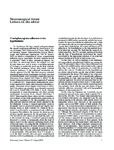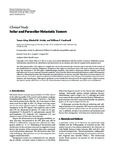|
|
Creator | Title | Description | Subject | Date |
| 251 |
 |
Kestle, John R. W. | Relationship of intraoperative electrophysiological criteria to outcome after selective functional posterior rhizotomy | At British Columbia's Children's Hospital, the criteria used in selective functional posterior rhizotomy (SFPR) evolved in three distinct phases. In Phase 1 the electrophysiological criteria for abnormality included a low threshold to a single stimulation, a sustained response to 50-Hz stimulation, ... | Selective posterior rhizotomy; Electrophysiological criteria; Intraoperative electrical stimulation | 1995 |
| 252 |
 |
Schmidt, Meic H. | Repeated operations for infiltrative low-grade gliomas without intervening therapy | Progression of infiltrative low-grade gliomas (LGGs) has been reported previously. The limitations of such studies include diverse histological grading systems, intervening therapy, and the lack of histological confirmation of malignant tumor progression. The aim of this study was to determine tumo... | Infiltrative low-grade gliomas; LGG; Tumor progression; Repeated operations; Tumor recurrence | 2003 |
| 253 |
 |
Couldwell, William T. | Resident curriculum guidelines for neurosurgery | This curriculum was created to detail the body of knowledge that should be attained by an individual completing residency training in neurological surgery. The specific structure of resident education in neurological surgery is defined by the American Board of Neurological Surgery, and each program... | Residency training; Neurological surgery | 2000 |
| 254 |
 |
Dailey, Andrew T. | Resolution of an actinomycotic abscess with nonsurgical treatment: case report | A CASE OF actinomycotic brain abscess is presented. Conservative treatment by prolonged administration of antibiotics after needle biopsy showed complete resolution of the abscess. Previously reported cases suggest that definitive treatment requires excision or open surgical drainage of the abscess... | Actinomycotic abscess; Brain abscess; Actinomyces israelii; Nonsurgical treatment | 1993 |
| 255 |
 |
Couldwell, William T. | Resolution of an anterior-inferior cerebellar artery feeding aneurysm with the treatment of a transverse-sigmoid dural arteriovenous fistula | The authors describe a 27-year old man who developed an unruptured anterior-inferior cerebellar artery feeding aneurysm from a transverse-sigmoid dAVF and its subsequent resolution with the treatment of the dAVF. The patient, with a known history of left transverse and sigmoid sinus thrombosis, pres... | Aneurysms; Dural Arteriovenous Fistulas; Endovascular therapy; Surgery | 2007 |
| 256 |
 |
Couldwell, William T. | Response to comment on: the combined transmastoid retro- and infralabyrinthine transjugular transcondylar transtubercular high cervical approach for resection of glomus jugulare tumors | We appreciate the comments by Dr. Sanna regarding our article (1). We recognize Dr. Sanna has much experience with these tumors and that, as cranial base surgeons, we should work as a team of neurosurgeons, otologists, and occasionally, head and neck surgeons and plastic surgeons. We also agree tha... | Jugular foramen tumor; Glomus jugulare tumors | 2007 |
| 257 |
 |
Couldwell, William T. | Response to Craniopharyngioma adherence to the hypothalamus | To The Editor: We have viewed with great interest the special supplement published by Neurosurgical Focus in January 2013 (Neurosurgical Focus, Video Atlas of Operative Surgery: Intraventricular Lesions: Microscopic and Endoscopic Approaches, Vol 34: January 2013) in which a compilation of videos de... | | 2014-01-01 |
| 258 |
 |
Kestle, John R. W. | Response to editorial: summer shunting | We thank Dr. Scott for his review and comments about our report of shunt surgery complications in the summer. He makes two very good points. Clearly, different databases are suited for different purposes, and the NIS database used in the study by Smith and colleagues is well suited to evaluating t... | | 2006 |
| 259 |
 |
Kestle, John R. W.; Walker, Marion L. | Retained peritoneal shunt tubing causing hematuria | This 14-year-old boy with congenital hydrocephalus underwent initial shunt placement shortly after birth. During his first 6 years of life, multiple ventriculoperitoneal (VP) shunt revisions were performed to address seven shunt malfunctions and one shunt infection (Staphylococcus epidermidis). Dur... | | 2006 |
| 260 |
 |
Couldwell, William T. | Review by Oren N. Gottfried, M.D. and William T. Couldwell, M.D., Ph.D for Neurosurgery Journal Club. (Yadav JS, Wholey MH, Kuntz RE, et al: Protected carotid-artery stenting versus endarterectomy in high-risk patients.) | This is an important study that helps further define a role for carotid stenting as a therapeutic option for atherosclerotic carotid disease. There is a need for a larger-scale multi-centered trial with increased numbers patients and longer follow-up to identify appropriate patients for either endar... | Carotid Stenosis; Endarterectomy, Carotid; Stents | 2005-01-07 |
| 261 |
 |
Couldwell, William T.; MacDonald, Joel D. | Revision of vagal nerve stimulator electrodes: technical approach | Purpose To demonstrate the feasibility of complete removal of the vagal nerve stimulator electrode using microsurgical technique. Methods Operative databases at the University of Utah (1995 through 2002), Westchester Medical Center (1995 through 2001), and University of Arizona Health Sciences Ce... | Vagal nerve stimulation; Helical electrode; Electrode revision | 2004 |
| 262 |
 |
Dailey, Andrew T. | Risk factors for respiratory failure following operative stabilization of thoracic and lumbar spine fractures | Background: Respiratory failure is a serious complication that can adversely affect the hospital course and survival of multiply injured patients. Some studies have suggested that delayed surgical stabilization of spine fractures may increase the incidence of respiratory complications. However, the... | Respiratory failure; Operative stabilization; Thoracic spine; Lumbar spine | 2006 |
| 263 |
 |
Schmidt, Meic H. | Rod derotation techniques for thoracolumbar spinal deformity | OBJECTIVE: The operative correction of scoliosis requires multiple intraoperative techniques and tools to achieve an adequate result. Frequently, multiple methods are used to accomplish this, such as rod cantilever techniques, in situ bending, Smith-Petersen and pedicle subtraction osteotomies, clo... | | 2008-01-01 |
| 264 |
 |
Kestle, John R. W. | Role of angiography following aneurysm surgery | The postoperative angiograms in 66 patients who underwent craniotomy for clipping of 78 cerebral aneurysms were reviewed. Indications for urgent postoperative angiography included neurological deficit or repeat subarachnoid hemorrhage. Routine postoperative angiograms were carried out in the remai... | Postoperative angiography; Aneurysm rest; Cerebral angiography; Vascular occlusion | 1993 |
| 265 |
 |
Couldwell, William T. | Role of CCM1 loss-of-function-induced endothelial-to-mesenchymal transition in the development of cavernous malformations | Cerebral cavernous malformations (CCM) occur in two variants: sporadic and familial. Mutations in three genes-CCM1, CCM2, and CCM3-play a role in both subtypes, with mouse models showing the development of multiple cavernous malformations in animals with loss of function in any of these three genes.... | | 2013-01-01 |
| 266 |
 |
Schmidt, Meic H. | Role of light-emitting diodes for photodynamic therapy of brain tumors | The development of more effective light sources for Photodynamic Therapy (PDT) of brain tumors would be of benefit for both research and clinical application. In this study, the use of light-emitting diode arrays for PDT of brain tumors with Photofrin® porfimer sodium was investigated. An inflatabl... | Aluminum Gallium Arsenide; Photodynamic therapy; Brain tumors; Photofrin | 1996 |
| 267 |
 |
Schmidt, Meic H. | Role of photodynamic therapy in posterior fossa brain tumors: a preclinical study in a canine glioma model | Photodynamic therapy was studied in dogs with and without posterior fossa glioblastomas. This mode of therapy consisted of intravenous administration of Photofrin-II at doses ranging from 0.75 to 4 mg/kg 24 hours prior to laser light irradiation in the posterior fossa. Tissue levels of Photofrin-l... | Brain neoplasm; Posterior fossa; Photodynamic therapy; Glioblastomas; Dog; Photofrin-II; Canine glioma model | 1993 |
| 268 |
 |
Schmidt, Meic H. | Role of thoracoscopic spinal surgery in the management of pyogenic vertebral osteomyelitis | Study Design. Case report, operative technique. Objectives. Vertebral osteomyelitis is frequently associated with elderly and debilitated patients who have significant medical comorbidities. If surgical debridement is contemplated, an open anterior approach like a thoracotomy can be associated with... | Thoracoscopic spinal surgery; Pyogenic vertebral osteomyelitis | 2004 |
| 269 |
 |
Couldwell, William T.; Schmidt, Richard H. | Ruptured intracranial dermoid cysts: clinical, radiographic, and surgical features | Intracranial dermoid cysts are pathologically characterized by a thick, stratified squamous epithelium cyst wall containing dermal elements. Rupture into the subarachnoid spaces and ventricles is extremely rare. We review the clinical, radiographic, and surgical features of eight ruptured dermoid c... | Dermoid cyst; Intracranial; Rupture; Tumor | 2008 |
| 270 |
 |
Dailey, Andrew T. | Sciatic nerve sarcoidosis: utility of magnetic resonance peripheral nerve imaging and treatment with radiation therapy | Sarcoidosis may involve both the central and peripheral nervous system, although peripheral nerve manifestations are usually seen late in the disease. In this report, the authors describe a case of sarcoidosis in a 22-year-old woman who presented with a foot drop. Although results of conventional lu... | Peripheral nerve imaging; Radiation therapy | 2004 |
| 271 |
 |
Couldwell, William T. | Sellar and parasellar metastatic tumors | The sellar and parasellar (SPS) region is a complex area rich in vital neurovascular structures a first manifestation of a systemic malignancy. Metastases to this region are rare; breast cancer is the most common source among those that metastasize to the SPS region. Ophthalmoplegia, headache, retro... | | 2012-01-01 |
| 272 |
 |
Digre, Kathleen B. | Serum vitamin A concentration is elevated in idiopathic intracranial hypertension. | OBJECTIVE: The primary purpose was to investigate whether serum vitamin A concentration is associated with idiopathic intracranial hypertension (IIH). The secondary aim was to obtain pilot data regarding the amount of vitamin A ingested by patients and controls. BACKGROUND: Vitamin A is an attractiv... | Vitamin A; Retinol; Idiopathic intracranial hypertension; Chromatography | 2007-02-01 |
| 273 |
 |
Kestle, John R. W. | Shunt insertion in the summer: is it safe? | Object. The potential for increased complications related to the arrival of new residents in July each year has not previously been demonstrated in the neurosurgical literature. The authors investigated this phenomenon in children undergoing cerebrospinal fluid shunt surgery. Methods. Data were ob... | Ventriculoperitoneal shunt; July effect; Complication; Shunt insertion | 2006 |
| 274 |
 |
Kestle, John R. W. | Significance of bacteriologically positive ventriculoperitoneal shunt components in the absence of other signs of shunt infection | The purpose of this study was to determine the significance of "asymptomatic bacteriological shunt contamination" (ABSC), defined as a positive bacteriological culture found on a ventricular shunt component in the absence of bacteria in the cerebrospinal fluid (CSF) culture and/or clinical evidence ... | Ventricular shunt; Shunt infection; Ventriculoperitoneal shunt; Asymptomatic bacteriological; Shunt contamination | 1996 |
| 275 |
 |
Couldwell, William T. | Simple closure following transsphenoidal surgery | The most common nonendocrine complication after transsphenoidal surgery is cerebrospinal fluid (CSF) leak. Many neurosurgeons have advocated the routine reconstruction of the floor of the sella turcica using autologous fat, muscle, fascia, and either cartilage or bone after transsphenoidal surgery t... | | 2006 |

























